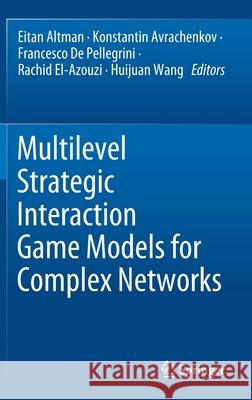Multilevel Strategic Interaction Game Models for Complex Networks » książka



Multilevel Strategic Interaction Game Models for Complex Networks
ISBN-13: 9783030244545 / Angielski / Twarda / 2019 / 322 str.
Multilevel Strategic Interaction Game Models for Complex Networks
ISBN-13: 9783030244545 / Angielski / Twarda / 2019 / 322 str.
(netto: 427,64 VAT: 5%)
Najniższa cena z 30 dni: 424,07 zł
ok. 16-18 dni roboczych.
Darmowa dostawa!
Preface
Part I Multi-Level Evolutionary Games
Chapter 1 Introduction
Chapter 2 Altruism in Groups
2.1 Classical Evolutionary Games and ESS; 2.2 New natural concept on evolutionary games; 2.3 Analysis of N-groups games with two strategies; 2.4 Some Examples; 2.5 Multiple Access Control; 2.6 Conclusions
Chapter 3 From Egoism to Altruism in Groups
3.1 System Model; 3.2 Utility Functions; 3.3 Computing the ESS; 3.4 Replicator Dynamics; 3.5 Optimization Issues; 3.6 Numerical Results; 3.7 Conclusion
Chapter 4 Evolutionary Games in Interacting Communities
4.1 Introduction; 4.2 Evolutionarily Stable Strategies; 4.3 Two-community two-strategy model; 4.4 Replicator Dynamics; 4.5 Application to Hawk- Dove game; 4.6 Interacting communities on random graphs; 4.7 Conclusion; 4.8 Proofs
Chapter 5 Random Time Delays in Evolutionary Game Dynamics
5.1 Evolutionary Games; 5.2 Replicator dynamics with continuous random delays; 5.3 Replicator dynamics with one delayed strategy; 5.4 Conclusions; 5.5 Proof of Theorem 8; 5.6 Proof of Theorem 10
Chapter 6 Coupled State Policy Dynamics in Evolutionary Games
6.1 Standard Evolutionary Game Theory; 6.2 Individual State in EGT framework; 6.3 Two time-scales behavior; 6.4 Numerical Illustrations; 6.5 Conclusions and perspectives
Part II Epidemics/Information Diffusion
Chapter 7 Introduction
Chapter 8 Community Network with Equitable Partitions
8.1 Equitable Partitions; 8.2 Example; 8.3 Almost equitable partitions; 8.4 Conclusion
9.1 Effect on the Epidemic Threshold; 9.2 Effect of the Spatial Constraints of Interconnected Networks
Chapter 10 Co-Evolution/ Adaptive Epidemics
10.1 Adaptive SIS model; 10.2 Comparison of the ASIS and AID model; 10.3 Conclusion
Part III Networking Games
Chapter 11 Introduction
Chapter 12 “Beat your Rival” Routing Games
12.0.1 Solution concept; 12.1 Model and Game Theoretic Formulations; 12.2 Bottleneck Routing Games; 12.3 Additive Routing Games; 12.4 Conclusions
Chapter 13 Network Formation Games with Teams
13.1 Network Formation Games with Teams: Basic definitions; 13.2 Network Formation Games with Teams: A Motivating Example; 13.3 Stability of Networks Against Teams’ Coalitions; 13.4 Dynamic formation of networks under coalitions; 13.5 Simulation Results; 13.6 Conclusions
Chapter 14 Peering vs Transit: A game theoretical model for autonomous systems connectivity
14.1 Introduction; 14.2 Related Work; 14.3 Scenario; 14.4 General Model; 14.5 Minimal Complexity Model (MCM); 14.6 Simulations; 14.7 Conclusions; 14.8 Appendix
15.1 Introduction; 15.2 Computing the equilibrium; 15.3 Paradox and Price of Anarchy; 15.4 Collusions and Conclusions
Part IV Intermittency in Complex Systems
Chapter 16 Introduction
17 Models with Adaptive Intermittent Behavior
17.1 Tangled Nature Model; 17.2 The Stochastic Replicator Model
Chapter 18 Outline of the Forecasting Procedure
18.1 Mean-Field Description; 18.2 Linear Stability Theory: Continuum Approximation; 18.3 TNM Mean Field Description; 18.4 SRM Mean Field Description
Chapter 19 Forecasting Procedure Based on Full Information
19.1 Procedure; 19.2 Results; 19.3 Analysis of the Stability Indicator Q(t); 19.4 Discussion
Chapter 20 Procedures with Incomplete Information
20.1 Interactions with Error; 20.2 New Procedure; 20.3 Results; 20.4
Rachid El-Azouzi is the co-recipient of 5 Best Paper Awards, and he has authored or co-authored over 70 journal articles and book chapters and over 170 conference publications, in the general areas of game theory, complex system, Evolutionary games, networking games, wireless networks, network economics, stochastic control and delay tolerant networks.
This book provides a state-of-the-art overview on the dynamics and coevolution in multi-level strategic interaction games. As such it summarizes the results of the European CONGAS project, which developed new mathematical models and tools for the analysis, prediction and control of dynamical processes in systems possessing a rich multi-level structure and a web of interwoven interactions among elements with autonomous decision-making capabilities.
The framework is built around game theoretical concepts, in particular evolutionary and multi-resolution games, and includes also techniques drawn from graph theory, statistical mechanics, control and optimization theory. Specific attention is devoted to systems that are prone to intermittency and catastrophic events due to the effect of collective dynamics.
1997-2025 DolnySlask.com Agencja Internetowa
KrainaKsiazek.PL - Księgarnia Internetowa









